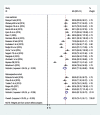A systematic review and meta-analysis on adoption of WHO-recommended infant feeding practices among HIV positive mothers in Ethiopia
- PMID: 33685405
- PMCID: PMC7941701
- DOI: 10.1186/s12884-021-03662-3
A systematic review and meta-analysis on adoption of WHO-recommended infant feeding practices among HIV positive mothers in Ethiopia
Abstract
Background: The prevalence of the World Health Organization (WHO) recommended infant feeding practices for HIV exposed infants is low in developing countries. There is no nationwide representative study was done in Ethiopia. Therefore, this study aimed to assess the pooled prevalence of WHO-recommended infant feeding practices among HIV-positive mothers in Ethiopia.
Methods: EMBASE, PubMed, Google Scholar, CINHAL, Web of Science, Cochrane library, and hand searches of references were extensively searched to find out the primary articles. This study was included in all primary articles published in peer review journals regarding the recommended infant feeding practices in Ethiopia. Reviewers were used a standardized Microsoft Excel format to extract the data and analyzed it with Stata 11 version software. The pooled prevalence of recommended infant feeding practices among HIV exposed infants was estimated by a random-effect model. The sources of variation between the studies were identified by the I 2 statistics test. Furthermore, the source of heterogeneity was checked by subgroup and meta-regression analyses. Sensitivity analysis was also carried out for included articles to identify extreme values that affect the outcome of pooled results.
Results: A total of twenty-one articles were included in this study. The random effect pooled prevalence of WHO-recommended infant feeding practices in Ethiopia was 82.76% (95% Confidence Interval [CI]: 75.4, 90.11) with the heterogeneity of I2 = 93.7 with a value of p < 0.001. The subgroup analysis result showed that the highest prevalence of WHO-recommended infant feeding practices was observed in the retrospective cohort study design, 89.45%, and the lowest prevalence was found in cross-sectional studies, 80.67%. Mothers who disclosed their HIV serostatus to their spouses OR = 2.88(2.27, 3.66) and attended antenatal care visits OR = 4.62(3.13, 6.83) were more likely to follow the WHO-recommended infant feeding practices than their counterparts.
Conclusion: Two out of ten HIV exposed infants received mixed feeding in Ethiopia. Health professionals should support and counsel HIV positive mothers to disclose their HIV serostatus to their spouses and advertisements in general or community health workers can get this message out to encourage using antenatal care services during the pregnancy period were recommended to increase the adoption of WHO recommended infant feeding practices and decrease their infant's risk of morbidity, including HIV infection.
Keywords: Ethiopia; Exclusive breastfeeding; HIV positive mothers; Infant feeding options; Prevalence.
Conflict of interest statement
I declared that we have no competing interests.
Figures




References
-
- World Health Organization. HIV/AIDS factsheet. WHO; 2019. https://www.who.int/docs/default-source/searo/myanmar/factsheet-hiv-aids....
-
- Central Statistical Agency (CSA) [Ethiopia] and ICF . Ethiopia demographic and health survey 2016: HIV report. Addis Ababa and Rockville: CSA and ICF; 2018.
-
- World Health Organization. Guidelines on HIV and infant feeding 2010: principles and recommendations for infant feeding in the context of HIV and a summary of evidence. World Health Organization; 2010. - PubMed
-
- Muluye D, Woldeyohannes D, Gizachew M, Tiruneh M. Infant feeding practice and associated factors of HIV positive mothers attending prevention of mother to child transmission and antiretroviral therapy clinics in Gondar town health institutions, Northwest Ethiopia. BMC Public Health. 2012;12(1):240. doi: 10.1186/1471-2458-12-240. - DOI - PMC - PubMed
Publication types
MeSH terms
LinkOut - more resources
Full Text Sources
Other Literature Sources
Medical

